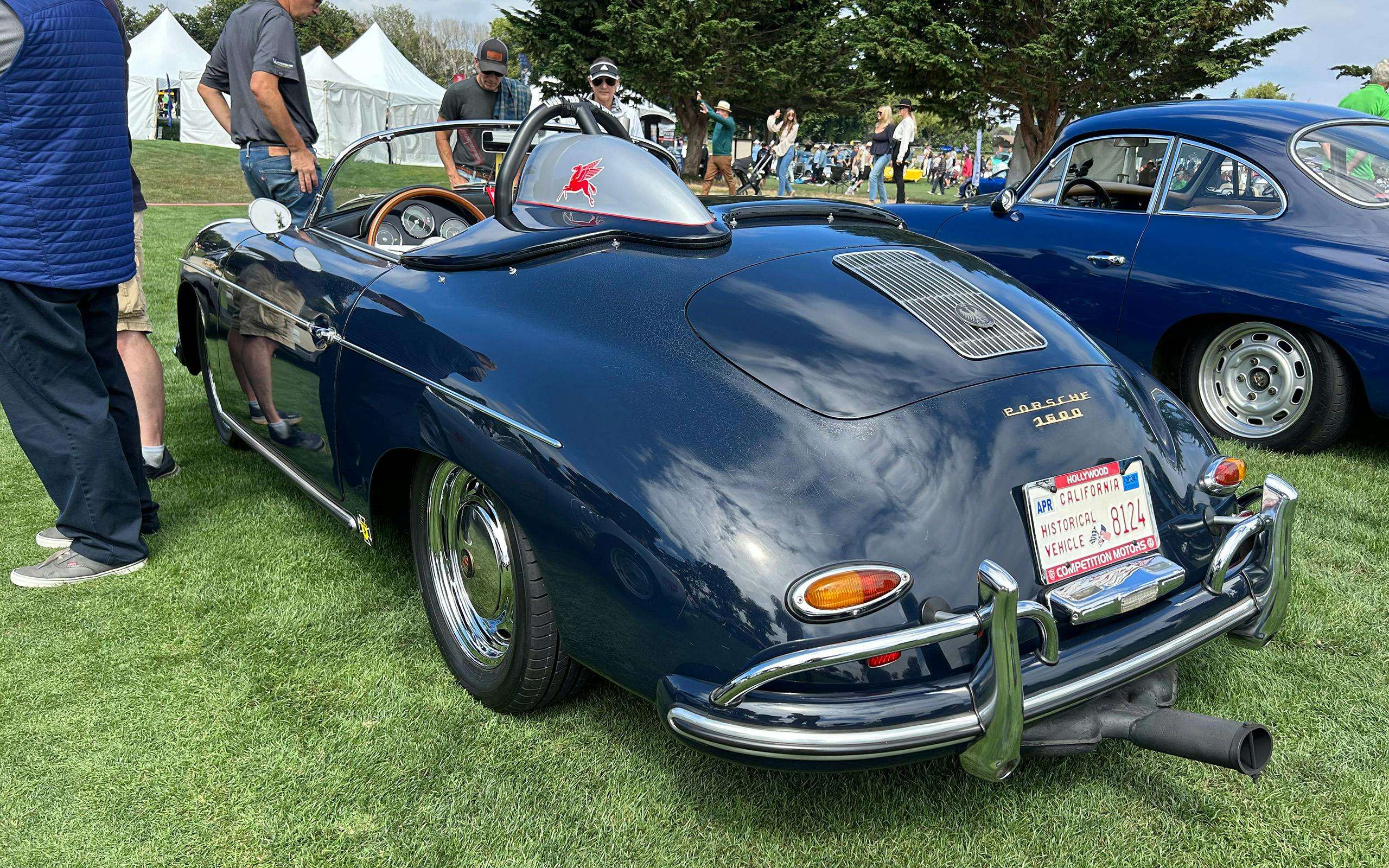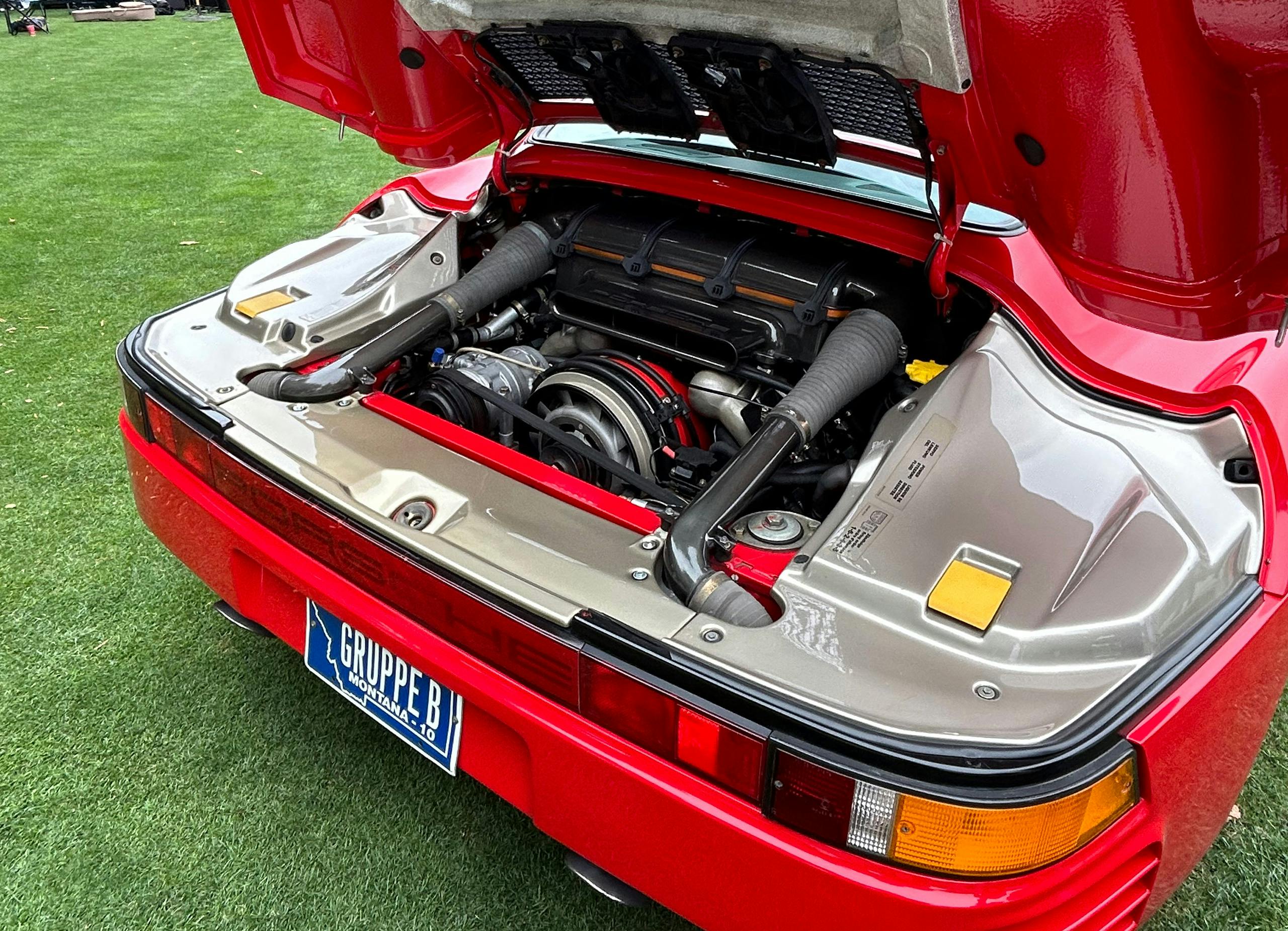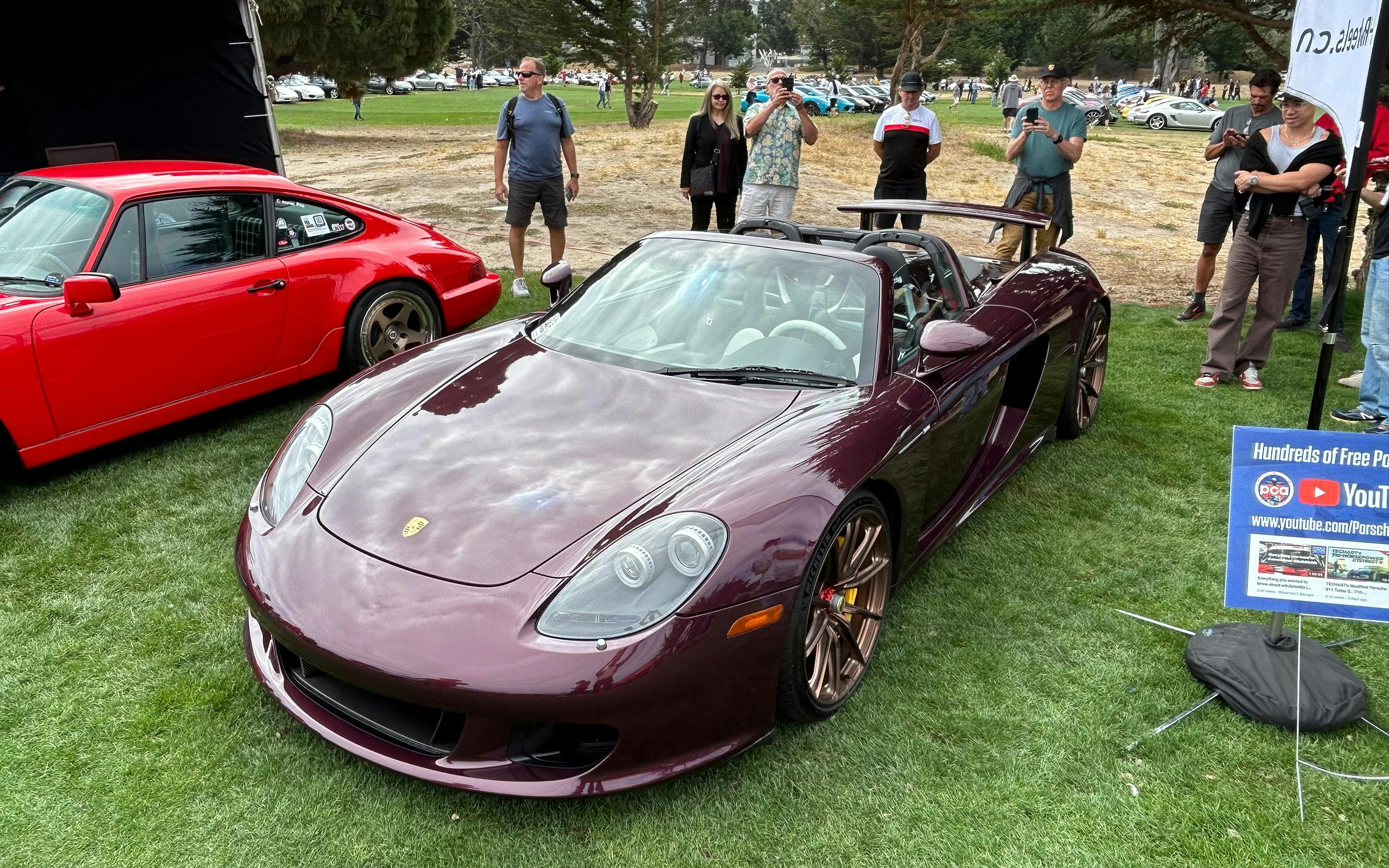Media | Articles
8 stars of the Porsche Werks Reunion Monterey … without 911 badges
Mention Porsche to anyone, and their first thought almost certainly involves some sort of 911. The swooping sports car has anchored Porsche’s lineup (and its lore) for 60 years, and well over a million units have hit the road since its inception in 1963, covering every nook and cranny of the market. There is no Porsche without the 911.
This much was plainly evident at the ninth annual Porsche Werks Reunion Monterey, held at the Monterey Pines Golf Club near the airport. The show’s main grounds hosted 911s of all shapes and sizes, from early first-gen (1963–72) cars to svelte G-body (1973–89) cars to modern 992s (2019–now), and every rare or eccentric model in between.
But the event also featured scores of other cars proudly bearing the Porsche crest on their hoods, hind ends, or fenders. Below is a round-up of eight particularly charming Porsches that are not the 911, all of which showed up for Werks Reunion Monterey. Some of these are specific cars, while others are a collection of a specific model. Similarly, some are bone-stock, nearly preservation-grade rides, while others caught my eye due to their tasteful—or downright ambitious—modifications. There was only one rule here: A 911 was a no-no!
1986 Porsche 944 Turbo
Produced from 1982 to 1991, the Porsche 944 was an example of making lemonade from lemons. It was based on the 924, a strange and somewhat maligned collaboration between Porsche and Volkswagen to produce a front-engined sports car. The 944 was an evolution of the 924, better in every way, and more than 163,000 were produced over its lifespan, which made it, at the time, Porsche’s most successful sports car to date.
In 1986, Porsche opted to turbocharge the 944’s 2.5-liter inline four-cylinder, creating the 944 Turbo. The car pictured here is an ’86, owned by Erik Wayne Lunn of Pleasanton, California. As Lunn tells it, when he acquired the car back in 2018, it wasn’t what he was originally looking for. “I kind of fell into the Porsche world,” he explained. “I was trying to buy a Lotus Seven at the time, but a deal fell apart. A friend of mine said, ‘Have you considered a Porsche?'” He had, but only briefly.
Marketplace
Buy and sell classics with confidence
Then, this car came across his desk. It was in fair shape but had its share of mechanical issues. Lunn set about refreshing and modifying the car to fit his vision—he called it modifying for “sports purpose.” The car now boasts a built engine producing somewhere around 280 horsepower—a fair bump from the 217-hp rating these things carried from the factory. It has plenty of suspension work as well, including a rear torsion bar delete, Koni adjustable shocks at all four corners, new strut braces front and rear, a Club Sport steering wheel, and 18-inch forged wheels. “[I did] everything you can do to sharpen these, and now it’s an absolutely delightful car to throw around.”
1971 Porsche 914/6 Tribute
Porsche and Volkswagen have had their fair share of joint projects over the years, perhaps none as recognizable as the 914 sports car. Upon the 914’s 1970 debut, it featured two engines: A 1.7-liter air-cooled flat-four from Volkswagen making 80 hp, or a 2.0-liter air-cooled flat-six making 110 hp, cribbed from the contemporary Porsche 911 T. Slow sales of the pricer Porsche-powered 914, dubbed the 914/6, led to the six-pot model being discontinued in 1972.
This car, owned by Bruce and Carmie Brincka of Folsom, California, began life as a 1.7-liter 914/4. “Growing up, I sat in the back seat of my dad’s 911, so I loved that [flat-six] sound” Brincka explained. “My sister bought a 914 when I was young, and I ended up loving both cars for different reasons. But I always gravitated toward the looks of the 914.”
This is Bruce’s third 914, but the first one to feature that flat-six sound he loved. In place of the little four-pot, the blazing orange 914 now boasts a 3.2-liter flat-six from a 1988 911 Carrera. It’s paired with a 915 manual gearbox from 1986. “A friend of mine actually built this car,” he explained. “It was on the East Coast for a while, but I had the chance to buy it back.”
Additional modifications include flared fenders at all four corners, Maxilite Fuchs wheels, front brakes from a Porsche Boxster, and new shocks front and rear. Inside, a smattering of houndstooth fabric accents the seats and door panels. There are practical mods, too, like the center console that Bruce fabricated for day-to-day comfort. “My wife told me, ‘I’m tired of holding the drinks!'” That awesome roadway carpet up front? “That’s there so my grandkids have a place to play when we go to car shows.” Who says fun and family-friendly can’t exist in a two-door, mid-engined sports car?
1958 Porsche 356A T2 Speedster
In 1956, Porsche unveiled the 356A, a comprehensively revamped version of the 356 that is widely regarded as Porsche’s first mass-market automobile. Max Hoffman, the famed businessman and car importer from New York City, bent Porsche’s ear and suggested that it make a no-frills, open-top version of the 356A called the “Speedster” for the American market. The Speedsters were well received, but most of them were sold, used hard as race cars, and then discarded.
Luckily, the car seen here, owned by Steve Raucher of California, escaped that fate. It’s a 1958 model, the last year of the Speedster run. Raucher’s research showed that this example was produced about 150 Speedsters before the final unit rolled off the line.
It may not have been used and discarded, but this 356A Speedster has still seen its fair share of drama. Raucher’s late father, a highly-regarded West Coast 356 authority, purchased the car in 1974, after it had spent its early days in Honolulu, Hawaii, and then in Colorado. About two months after his father purchased it, it was stolen in the Los Angeles area by a circle of thieves notorious for targeting Porsche 356s. The car, originally painted Tangerine Orange, was repainted to the navy seen here, and the original bumpers were removed. The thieves flared the fenders as well (Raucher has since repaired them) to further obscure the car.
The elder Raucher ended up taking out an ad in a local collector car magazine asking for help finding the car. Eventually, he was contacted by one Bruce Canepa—yes, the guy who founded the custom and refurbishing shop famous for its work on all sorts of Porsches—who said he may have spotted the car in the Santa Cruz mountains. Sure enough, with the help of Raucher’s father, the Santa Cruz police organized a sting on the small shop where Canepa had spotted the car, busting up the ring of thieves in the process.
The car returned to Steve’s father’s possession, albeit now decidedly unoriginal. Rather than lament the Porsche’s somewhat beleaguered state, Raucher embraced it, going full “outlaw.” The car now boasts disc brakes and an air-cooled flat-four from a ’66 912. “It’s a mixture of original and reproduction modified,” explained Raucher. There’s a fiberglass headrest cover over the soft top, but it looks right at home. “I wanted the car to look a little racier, so I had this piece custom-made. In period, a lot of the cars that raced looked this way.”
Raucher is planning to strip the paint and return the car to its original color scheme soon, but in the meantime, we’re happy to appreciate it for how it looks now.
Overlanding-ready Porsche Cayennes
This one isn’t a specific car, but rather, a growing trend within the Porsche community that has been spearheaded by a somewhat controversial model. Hindsight is 20/20, but the Cayenne is widely regarded as the reason Porsche can still build the 911—and the 718 Boxster and Cayman twins, and scores of other neat sports cars—today. And it’s not like the Cayenne wasn’t a seriously capable machine from the get-go.
The Cayenne S, specifically, seems to be the popular one to utilize for an overlanding build. It boasted a two-speed transfer case, a locking center differential, and an optional rear locker.
Porsche Palm Springs built the blue and white example seen in the first picture of this gallery. Christian Cirillo, a technician at the dealership, explained how this 2008 Cayenne S went from an on-road cruiser to an off-road monster. “[The Cayenne] was in typical second-hand condition when we got our hands on it,” he explained. “A little rough around the edges, in need of some work.”
Cirillo and his team fitted the Cayenne with Bilstein coilovers, Eurowise upper control arms to give the suspension more articulation, and the 33-inch Mickey Thompson tires that you see here. “It rides a lot better [with the modifications],” said Cirillo. “It’s night and day, this thing at high speed just soaks up the bumps.”
His team didn’t just call it good with a shock and tire package, though. They also fitted the Porsche with a roof-top tent and a hitch-mounted bike rack—upon which a Porsche E-bike sits—as well as a front bumper with four additional Hella lights.
The other Cayennes in this gallery were either elsewhere on the show field, or just tucked away in the parking area. As overlanding continues to gain traction, expect these sorts of builds to follow suit.
1957 Porsche 356A Carrera GT
In the early 1950s, a talented young engineer named Ernst Fuhrmann created a highly advanced engine that would kickstart Porsche’s dominance in the world of motorsports. The “Fuhrmann Four-Cam” engine was a 1.5-liter, air-cooled flat-four with four overhead camshafts driven by bevel-gear shafts that turned off a central crank. The skunkworks engine went on to propel the 550 Spyder to remarkable victories in everything from hill climbs to Le Mans.
In 1954, the engine made its way into a run of Porsche 356s, which took on the “Carrera” moniker, named after the grueling Carrera Panamericana race. Those 356 Carreras are some of the most sought-after cars in Porsche’s history.
This car, now owned by Gregg Blue of Maui, Hawaii, was put into storage in Brooklyn, New York, in 1969, where it remained until 2016. It’s one of the few known completely original Carreras left in existence—original paint, original Fuhrmann Four-Cam engine, and original interior.
That hasn’t stopped Blue from enjoying the car immensely—he’s put over 23,000 miles on it in the last five years, driving road rallies and to and from shows all over the country. (Peep those front license plates, stacked one atop the other!)
Despite its similarity to Steve Raucher’s 356A, this one made the list because how can you not tip your cap to someone enjoying such a special machine so voraciously?
1987 Porsche 928 S4
By the mid-1970s, slumping sales of the 911 coupled with the oil crisis of the 1970s had Porsche executives toying with the idea of a replacement car that combined certain elements of a luxury grand tourer with traits of a sports car. The resulting car, the 928, heralded a number of firsts for the brand. Namely, it was the first V-8-powered model from Porsche.
This car, owned by Jeff Mohler and his daughter, of San Jose, California, was purchased in 2015 for $1000 as a parts car. The Porsche had already undergone extensive restoration work by the previous owner, but Mohler and his daughter took things a step further, rebuilding some of the mechanicals and commissioning a full repaint in 2017. The car is now a daily driver, going out on weekend adventures as well as taking part in NASA HPDE track days at the hands of Mohler’s daughter.
In fact, she’s so smitten by the car, that she ended up buying her own 1985 928 when she turned 16. Additionally, she eventually enrolled at the Universal Technical Institute to further her automotive technician dreams, even being accepted into a highly competitive Porsche Technology Apprenticeship Program (PTAP). In that program, she gained experience disassembling and reassembling every Porsche model, including a test mule for the 918 Spyder. Mohler credits her for much of the work that has led to this black 928 S4 appearing in the condition it does today.
1986–88 Porsche 959
Considered to be the most technologically advanced car of its time, the Porsche 959 was an absolute stunner—in person and on track. The 959 began life as a Group B rally car, replete with a high-tech all-wheel-drive system that featured dynamic torque vectoring and adaptive suspension. The race car debuted in 1983 at the Frankfurt motor show, while the road-going version, created to satisfy the FIA’s homologation rules at the time, debuted two years later at the same event. Numerous issues ultimately delayed delivery of the road-going versions for more than a year, and the first ones didn’t reach customers until 1987.
The sequential, twin-turbocharged 2.8-liter flat-six engine was a derivative of the four-cam, 24-valve powerplant used in Porsche’s vaunted 956 and 962 race cars. It produced 444 hp and 369 lb-ft of torque, which, when coupled with the remarkably aerodynamic bodywork, allowed street 959s to reach speeds of 197 mph. Some variants could achieve an eye-watering 211 mph.
Porsche built just 337 959s, including 37 prototypes and pre-production models. The 959s are some of the most sought-after Porsches in existence today, largely because of what they did to push the brand forward in terms of performance and technology.
2004–2006 Porsche Carrera GT
It’s not a stretch to say that the Porsche Carrera GT was the spiritual successor to the 959. It was ambitious, advanced, and it caused plenty of ripples in the industry when it debuted. The Carrera GT featured a 603-hp, 5.7-liter V-10 engine that was originally developed in the early 1990s for a Formula 1 team, but was later shelved. The carbon-fiber monocoque chassis was extremely futuristic at the time, and the car employed all sorts of exotic materials and engineering, including inboard-mounted pushrod suspension.
Anytime you get to see one of these beasts in public is a special day. Porsche had originally planned to build 1500 units, but a change to U.S. airbag regulations cut that run short. In August 2005, Porsche announced that it would not continue production through the end of 2006 as originally planned. When production drew to an end in May 2006, just 1270 of the planned 1500 had been sold. Just 644 made their way to the U.S.
The combination of rarity, the gorgeous purple paint job, and the remarkable white interior landed this one a rightful spot on the list.

























































I applaud using the car as intended. But standing on the roof?! That kind of made me feel funny to look at.
but….he was wearing flip flops, at least